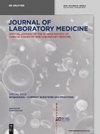Novel GLDC variants causing nonketotic hyperglycinemia in Chinese patients
IF 1.8
4区 医学
Q4 MEDICAL LABORATORY TECHNOLOGY
引用次数: 0
Abstract
Abstract Objectives Glycine decarboxylase gene (GLDC) mutations cause nonketotic hyperglycinemia (NKH). Patients of NKH usually have heterogeneous phenotypes including respiratory failure, lethargy, myoclonic jerks, and hypotonia. The excessive glycine accumulation in brain is a crucial pathogenic mechanism. Methods We performed a clinical phenotypic analysis of two Chinese patients and conducted whole exome sequencing to detect possible pathogenic genes. Transcriptional experiments were carried out to evaluate the impact of GLDC c.862-2A>G on GLDC transcript splicing. Results GLDC variants were identified in both patients who mainly presented with hypotonia, apnea, and lethargy patient 1 had compound heterozygous variants, which were c.334+5G>C and c.862-2A>G, while patient 2 had c.862-2A>G and c.2098C>G (p.P700A) in GLDC. Transcriptional experiments of GLDC c.862-2A>G revealed the presence of aberrant transcripts leading to truncated protein products. Conclusions Both patients were diagnosed with neonatal NKH. Two novel splice-site variations in GLDC, c.334+5G>C and c.862-2A>G, were identified. The c.862-2A>G variation was found in both patients and was confirmed to affect the splicing of GLDC. Our study enriched our knowledge of the genotypic and the phenotypic spectrum of NKH.导致中国患者非酮症性高血糖的新型GLDC变异
【摘要】目的甘氨酸脱羧酶基因(GLDC)突变引起非酮症型高糖血症(NKH)。NKH患者通常具有异质性表型,包括呼吸衰竭、嗜睡、肌阵挛性抽搐和张力低下。脑内过量的甘氨酸积累是一个重要的致病机制。方法对2例中国患者进行临床表型分析,并进行全外显子组测序以检测可能的致病基因。通过转录实验评估GLDC c.862-2A>G对GLDC转录物剪接的影响。结果两例GLDC患者均存在GLDC变异,主要表现为呼吸急促、呼吸暂停和嗜睡。患者1为复合杂合变异,为C. 334+5G>C和C. 862- 2a >G,患者2为C. 862- 2a >G和C. 2098c >G (p.P700A)。GLDC c.862-2A>G的转录实验显示存在导致蛋白产物截短的异常转录本。结论两例患者均为新生儿NKH。在GLDC中发现了两个新的剪接位点变异,C .334+5G>C和C .862- 2a >G。在两例患者中均发现c.862-2A >g变异,并证实其影响GLDC剪接。我们的研究丰富了我们对NKH基因型和表型谱的认识。
本文章由计算机程序翻译,如有差异,请以英文原文为准。
求助全文
约1分钟内获得全文
求助全文
来源期刊

Journal of Laboratory Medicine
Mathematics-Discrete Mathematics and Combinatorics
CiteScore
2.50
自引率
0.00%
发文量
39
审稿时长
10 weeks
期刊介绍:
The Journal of Laboratory Medicine (JLM) is a bi-monthly published journal that reports on the latest developments in laboratory medicine. Particular focus is placed on the diagnostic aspects of the clinical laboratory, although technical, regulatory, and educational topics are equally covered. The Journal specializes in the publication of high-standard, competent and timely review articles on clinical, methodological and pathogenic aspects of modern laboratory diagnostics. These reviews are critically reviewed by expert reviewers and JLM’s Associate Editors who are specialists in the various subdisciplines of laboratory medicine. In addition, JLM publishes original research articles, case reports, point/counterpoint articles and letters to the editor, all of which are peer reviewed by at least two experts in the field.
 求助内容:
求助内容: 应助结果提醒方式:
应助结果提醒方式:


